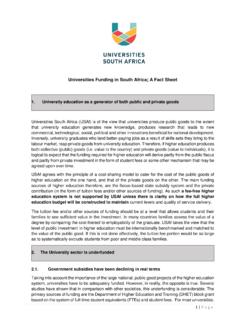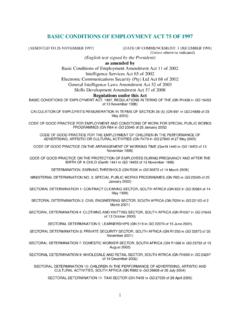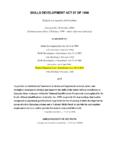Transcription of Employment Equity plan 2015 - 2020
1 UNIVERSITY OF CAPE TOWN Employment Equity plan 2015 - 2020 1 1. Introduction In terms of the Employment Equity Act (Act 55 1998 ) promulgated in 1998 South African employers are required to develop Employment Equity (EE) plans. These plans have to apply for periods not shorter than one year and no longer than five years. The purpose of the Act is to assist employers to achieve Equity by promoting equal opportunity and fair treatment in its Employment practices. The Act seeks to eliminate unfair discrimination and to promote the use of affirmative action measures. Since the promulgation of the Act, the University of Cape Town (UCT) has developed and implemented five EE Plans. This plan is for the period April 2015 March 2020. The current EE Plan for the institution has been compiled using information drawn from the individual EE Plans put together by all Faculties and PASS departments.
2 2. Developing the Plan Given the University s challenges in filling academic posts and the relative success the University has achieved in making its administrative staff more representative, the development of this Plan has focused on increasing the number of academic staff in designated The Employment Equity Plan for academic staff is based on the following: Data on undergraduate enrolment: In undergraduate programmes the intention in the University is that student numbers will remain fairly constant over the period. This means that the University will not be creating new Academic or Pass staff positions in most faculties. Data on Post-Graduate Enrolment: In postgraduate programmes most faculties will grow over this period and will require new staff/positions. It is expected that this growth will be required at the senior academic level.
3 Increases in On-line learning provision in the Continuous Professional Development environment: this will require new resources (specifically in EBE). Vacancies: Retirements in the Academic and PASS staff respectively will be relatively low. The estimated resignation rate which, calculated from historical data, will be between 1-4% overall over the 5 year period. (Note with the exception of Commerce which anticipates 25% resignation over the five year period.) Statistical Data Pools: Estimated numbers of suitably qualified persons for academic positions in the University are based on statistical data pools. Such data bases include the Higher Education Management Information System (HEMIS) which provides data on all graduates nationally, Higher Education Academic Data Analysis (HEADA) which provides data on all 1 Refer to Barriers to achieve the goals (EE) for further discussion on the challenges to achieving Employment Equity later in this document.
4 2 academics currently in universities nationally, professional bodies such as Health Professionals Council South Africa (HPCSA), South African Nursing Council etc. Promotion Rates: Some faculties estimated promotion rates, whilst other considered this too uncertain to predict. Where used, the assumption is that academics will progress by rank within a five year period. It is also assumed that at each rank a proportion of staff would have reached their appropriate level and will not be promoted further. 3. Numerical targets The numerical goals and targets are set out below as per the sectors. Tables 1 and 2 provide data for academics, Tables 3 and 4 for PASS staff in faculties and Tables 5 and 6 for PASS staff in UCT Departments. The most important data pool for recruitment above the lecturer level is the HEADA data and this is presented on page 7.
5 3 Table 1: Aggregated Academic Staff Academics Total no. of posts Year Male Female Foreign Nationals African Coloured Indian White No classif. A C I W No classif. Male Female No. % No. % No. % No. % No No. % No. % No. % No. % No No. % No. % Professor 242 2015 5 2 5 2 14 6 110 45 1 0 0 2 1 1 0 44 18 1 55 23 4 2 256 2020 12 5 9 4 17 7 93 36 1 4 2 5 2 4 2 57 22 1 45 18 8 3 Associate Professor 245 2015 7 3 17 7 8 3 60 24 0 4 2 6 2 6 2 67 27 0 49 20 21 9 257 2020 10 4 26 10 7 3 55 21 0 7 3 13 5 6 2 67 26 0 44 17 22 9 Senior Lecturer 391 2015 8 2 13 3 15 4 96 25 2 10 3 18 5 9 2 120 31 1 71 18 28 7 412 2020 16 4 25 6 19 5 99 24 2 17 4 25 6 13 3 110 27 1 59 14 26 6 Lecturer 414 2015 16 4 25 6 7 2 61 15 1 20 5 54 13 25 6 131 32 0 40 10 34 8 442 2020 31 7 33 7 14 3 61 14 1 31 7 58 13 29 7 127 29 0 30 7 27 6 Disability 9 20152020 0 0 0 0 0 0 4 0 0 0 0 1 0 0 0 1 0 0 2 0 1 0 Total (2015) 1292 36 3 60 5 44 3 331 26 4 34 3 80 6 41 3 362 28 2 215 17 87 7 Total (2020)
6 1367 69 5 93 7 57 4 308 23 4 59 4 101 7 52 4 361 26 2 178 13 83 6 The table below provides a breakdown of academic staff by rank and generic black and white population group. 4 Table 2: Percentage breakdown of Academics by black and white groups at UCT Academics Year All black % White % Foreign Nationals % Total Professor 2015 27 11 154 64 59 25 240 2020 51 20 150 59 53 21 254 Associate Professor 2015 48 20 127 52 70 29 245 2020 69 27 122 47 66 26 257 Senior Lecturer 2015 73 19 216 56 99 26 388 2020 115 28 209 51 85 21 409 Lecturer 2015 147 36 192 46 74 18 413 2020 196 44 188 43 57 13 441 Disability 2015-2020 1 13 5 63 3 38 8 Total (2015) 296 23 689 54 302 23 1286 Total (2020) 432 32 669 49 261 19 1361 5 Tables 3: Aggregated data for PASS Staff in Faculties Table Occupational Levels Pay Classes Year Male Female Foreign Nationals Total number of Posts African Coloured Indian White No clas sif.
7 A C I W No classif. Male Female No. % No. % No. % No. % No. No. % No. % No. % No. % No. No. % No. % Top management PC13PG1 0 2015 0 0 0 0 0 0 0 0 0 0 0 0 0 0 0 0 0 0 0 0 0 0 0 2020 0 0 0 0 0 0 0 0 0 0 0 0 0 0 0 0 0 0 0 0 0 0 Senior management PC13PG2, PC13PG3 4 2015 0 0 0 0 0 0 2 0 0 0 0 0 0 0 0 1 0 0 1 0 0 0 4 2020 0 0 1 0 0 0 1 0 0 0 0 0 0 1 0 0 0 0 1 0 0 0 Professionally qualified, mid-management PC13PG4, PC13PG5, PC12 42 2015 0 0 4 10 4 10 9 21 0 2 5 1 2 2 5 12 29 0 5 12 3 7 50 2020 4 8 8 16 4 8 7 14 0 4 8 5 10 3 6 8 16 0 4 8 3 6 Skilled technical, academically qualified, junior management PC11, PC10, PC09, PC08 607 2015 20 3 85 14 5 1 55 9 0 28 5 170 28 31 5 130 21 2 30 5 51 8 615 2020 37 6 93 15 9 1 46 7 0 47 8 175 28 33 5 101 16 2 27 4 45 7 Semi-skilled and discretionary decision making PC07, PC06, PC05, PC04, PC03 523 2015 30 6 111 21 1 0 6 1 0 63 12 232 44 9 2 46 9 0 6 1 19 4 554 2020 48 9 109 20 5 1 7 1 0 76 14 232 42 13 2 40 7 0 6 1 18 3 Unskilled and defined decision making PC02, PC01 0 2015-2020 0 0 0 0 0 0 0 0 0 0 0 0 0 0 0 0 0 0 0 0 0 0 Disability 4 0 0 0 0 0 0 0 0 0 0 0 0 0 0 0 0 0 0 0 0 0 0 Total (2015) 1176 50 4 200 17 10 1 72 6 0 93 8 403 34 42 4 189 16 2 42 4 73 6 Total (2020) 1223 89 7 211 17 18 1 61 5 0 127 10 412 34 50 4 149 12 2 38 3 66 5 6 Table 4.
8 Percentage breakdown of PASS Staff in Faculties by race at UCT Occupational Levels Pay Classes Year All black % White % Foreign Nationals % Total Top management PC13PG1 2015 0 0 0 0 0 0 0 2020 0 0 0 0 0 0 0 Senior management PC13PG2, PC13PG3 2015 0 0 3 75 1 25 4 2020 2 50 1 25 1 25 4 Professionally qualified, mid-management PC13PG4, PC13PG5, PC12 2015 13 31 21 50 8 19 42 2020 28 56 15 30 7 14 50 Skilled technical, academically qualified, junior management PC11, PC10, PC09, PC08 2015 339 56 187 31 81 13 607 2020 394 64 149 24 72 12 615 Semi-skilled and discretionary decision making PC07, PC06, PC05, PC04, PC03 2015 446 85 52 10 25 5 523 2020 483 87 47 9 24 4 554 Unskilled and defined decision making PC02, PC01 2015 0 0 0 0 0 0 0 2020 0 0 0 0 0 0 Disability 2015 0 0 0 0 0 0 0 2020 0 0 0 0 0 0 0 TOTALS 2015 798 68 263 22 115 10 1176 2020 907 74 212 17 104 9 1223 7 Table 5: Aggregated PASS Departments Staff Table Occupational Levels Pay Classes Year Male Female Foreign Nationals TOTALS African Coloured Indian White African Coloured Indian White Male Female No.
9 % No. % No. % No. % No. % No. % No. % No. % No. % No. % Top management PC13PG1 2015 0 0 0 0 0 0 1 100 0 0 0 0 0 0 0 0 0 0 0 0 1 2020 0 0 0 0 0 0 0 0 1 50 0 0 1 50 0 0 0 0 0 0 2 Senior management PC13PG2, PC13PG3 2015 1 3 5 16 1 3 8 26 0 0 0 0 3 10 11 35 2 6 0 0 31 2020 2 7 6 21 0 0 1 3 1 3 0 0 4 14 15 52 0 0 0 0 29 Professionally qualified, mid-management PC13PG4, PC13PG5, PC12 2015 5 4 24 19 2 2 40 31 4 3 12 9 3 2 30 23 6 5 3 2 129 2020 14 10 25 19 2 1 35 26 9 7 12 9 4 3 25 19 6 4 2 1 134 Skilled technical, academically qualified, junior management PC11, PC10, PC09, PC08 2015 37 7 96 17 11 2 60 11 50 9 167 30 19 3 100 18 16 3 9 2 565 2020 47 9 99 18 12 2 50 9 59 11 164 30 16 3 83 15 13 2 8 1 551 Semi-skilled and discretionary decision making PC07, PC06, PC05, PC04, PC03 2015 40 12 87 26 1 0 4 1 56 17 121 37 2 1 15 5 0 0 5 2 331 2020 56 17 89 26 0 0 4 1 60 18 109 32 3 1 12 4 0 0 5 1 338 Unskilled and defined decision making PC02, PC01 2015 0 0 0 0 0 0 1 100 0 0 0 0 0 0 0 0 0 0 0 0 1 2020 0 0 0 0 0 0 0 0 0 0 0 0 0 0 0 0 0 0 0 0 0 Disability 2015 0 0 1 17 0 0 1 17 0 0 3 50 0 0 1 17 0 0 0 0 6 2020 0 0 1 20 0 0 0 0 0 0 3 60 0 0 1 20 0 0 0 0 5 TOTALS 2015 83 8 213 20 15 1 115 11 110 10 303 28 27 3 157 15 24 2 17 2 1064 2020 119 11 220 21 14 1 90 8 130 12 288 27 28 3 136 13 19 2 15 1 1059 8 Table 6.
10 Percentage breakdown of PASS Departments Staff by race at UCT Occupational Levels Pay Classes Year All black % White % Foreign Nationals % Total Top management PC13PG1 2015 0 0 1 100 0 0 1 2020 2 100 0 0 0 0 2 Senior management PC13PG2, PC13PG3 2015 10 32 19 61 2 6 31 2020 13 45 16 55 0 0 29 Professionally qualified, mid-management PC13PG4, PC13PG5, PC12 2015 50 39 70 54 9 7 129 2020 66 49 60 45 8 6 134 Skilled technical, academically qualified, junior management PC11, PC10, PC09, PC08 2015 380 67 160 28 25 4 565 2020 397 72 133 24 21 4 551 Semi-skilled and discretionary decision making PC07, PC06, PC05, PC04, PC03 2015 307 93 19 6 5 2 331 2020 317 94 16 5 5 1 338 Unskilled and defined decision making PC02, PC01 2015 0 0 1 100 0 0 1 2020 0 0 0 0 0 0 0 Disability 2015 4 67 2 33 0 0 6 2020 4 80 1 0 0 5 TOTALS 2015 751 71 272 26 41 4 1064 2020 799 75 226 21 34 3 1059 Academic staff: targets and figures were derived from a process involving each faculty where targets were set for each occupational category (Professor, Associate Professor, Senior Lecturer, and Lecturer) and Disability2.







![Employment Equity Act [No. 55 of 1998]](/cache/preview/d/d/0/6/0/9/b/f/thumb-dd0609bf308cea3d6ac0c26c1659c10d.jpg)





